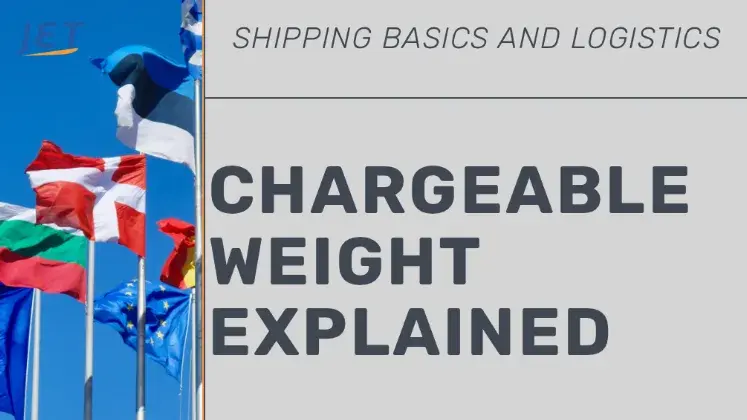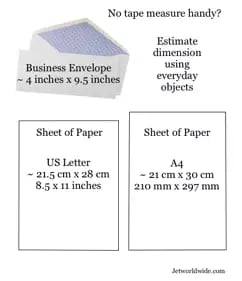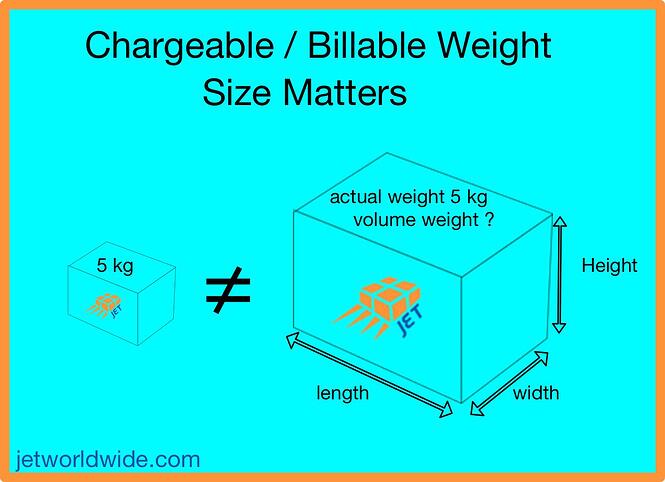
Actual, Chargeable, Billable and Volume weight explained
As more and more online companies ship international via air cargo, the question of chargeable weight - especially as it relates to volumetric pricing - can become significant unknown costs. While all shipments are subject to volume pricing, the affect on air - versus surface - is much more significant.
Due to international online e-commerce orders, an increasing percentage of cargo volume from China and Europe to Canada and the US is sent via air cargo.
Build Secure Low Cost Shipping Options With Jet

Common Chargeable Weight Formula
Parcels sent via common carriers, namely DHL, FedEx and UPS, are subject to a chargeable weight that equals to the the greater of the actual weight versus the "volume weight." The volume weight varies by carrier and method of transport but a common calculation for volume weight is: Length x width x height (in cm) / 5000 = volume weight in KG.

Download printable ruler on letter size sheet of paper
Download printable ruler on A4 sheet of paper
For example, a 40 cm x 40 cm x 40 cm box that weighs 5 kg
- Actual box weight: 5 kg
- Box dimensions: 40 cm x 40cm x 40cm = 64,000
- 64,000/ 5000= 12.8 kg
- Chargeable weight = 12.8 kg
Higher unit value of airfreight:
Airfreight shipments from China and Europe to North America tend be more valuable (as measured by value per kg). In the case of online e-commerce, the transaction price is often the retail price of the single transaction versus the wholesale unit costs of a bulk shipment.

Density of Air Cargo
Although air freight is traditionally used for high value and high density cargo, the growth of online orders is including more low density cargo that can have a big impact on the per parcel cost. For most carriers, parcel volume is calculated by assigning a minimum weight per cubic unit ( expressed in cubic inches or centimeters).
For air and ocean freight, the most often used volume unit of measure is cubic meters.
Package Measurements: Always round up - when calculating costs:
All carriers systematically scan and capture the weight and dimension of each package; rounding up to the nearest inch or centimetre.
It is important to note that carriers will not lower “over declared” dimensions. It is best to be accurate but not to over declare either the weight or dimension with the carrier.
“Chargeable weight/ billable”: Weight versus Volume

An important item to consider is the impact of the size of a shipment versus its weight. Space on an aircraft is considered as much a cost as the actual weight of the shipment.
Large “low density” cargo is charged at “volume weight” rather than actual weight.
As is the case for all airfreight shipments, carriers have developed formulas for equating the size of a shipment (cubic units) with the weight of the shipment (Kilograms). In the case of a large “low density” shipment, the “volume weight” will be charged (rather than the actual weight).
CBM = Cubic Meters
The term CBM is used often in shipping documents and rate quotes.
Steps to determine volume weight:
- Take the Length, Width and Height of the shipment in meters (or in centimetres and divide by 100).
- Multiply the Length x Width x Height = size in cubic meters
- Multiply the cubic meters (obtained in step 2) by the “volume factor” (provided by the carrier)
Book a shipment, get a quote.... or get some answers from Jet's experts! Contact our team for a confidential review on sending shipments from China, UK, EU to Canada and the US
Rates from your Chinese supplier vs. airfreight quote from China, UK, EU to Canada with Jet
We get many requests from Canadian and American companies whose international supplier manages the shipping but they want to confirm they have a competitive cost. Some companies prefer to have control of the logistics costs and processes and purchase the items under EXW terms.
- Incoterm: EXW?
- Many international transactions have the shipping term: EXW which essentially means that the buyer has to arrange for transport from China to Canada.
- EXW (Ex Works) is an international trade term which means all other transportation costs and risks are assumed by the buyer
Using Jet Worldwide, we manage the shipping on your behalf with complete transparency you can trust.
Jetworldwide.com







